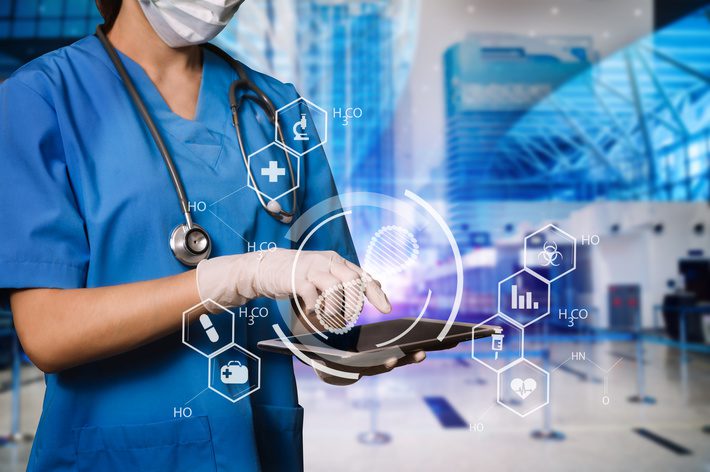
The past year has presented the medical industry with new challenges that humanity has hardly faced before. The situation in the world has accelerated the rapid pace of software development for medical devices and made people realize the irreplaceable role of high technology in their lives. Moreover, the interest of healthcare organizations in the Internet of Things has grown to keep pace with the era of telemedicine services.
The Internet of Things is a network of physical objects that receive information from the environment using sensors and software and transmit it to other devices or systems via the Internet. For healthcare, this means the integration of medical device software with clinic systems, which allows patient data to be transferred to the doctor without personal interaction, and much more. Below are a few key IoT perspectives that the medical world is taking advantage of today.
Diagnostics and Monitoring of Patients’ Condition
The use of the Internet of Things in healthcare makes accurate diagnosis and continuous monitoring of vital signs available to those who need it most:
- for cancer patients with immunodeficiency;
- for elderly people with limited mobility;
- for those suffering from chronic diseases such as diabetes, heart disease, epilepsy, or even Perthes disease.
Such technologies contribute to the development of personalized medicine when patient data is sent to doctors who carry out accurate diagnostics and select individual treatment. After all, gadgets using the capabilities of the Internet of Things can measure the vital functions of each patient:
- heart rate;
- breath;
- traffic;
- electrodermal activity;
- blood flow;
- The electrical activity of the muscles.
Among the outstanding solutions that use the Internet of Things, we should mention the development of the Israeli company EarlySense. A sensor under the patient’s mattress monitors heart rate, movement, and breathing. In case of any deviations, the medical staff sees them on their device.
This continuous non-contact monitoring allows early detection of urgent cases, reduces the number of admissions to intensive care units and emergencies with the resuscitation of patients, and prevents injury to patients if they accidentally fall out of bed. The device is also being used in some clinics to monitor COVID-19 patients isolated in hospital wards.
Another successful example is the SeizeIT kit, developed by the young Belgian-American company Byteflies in cooperation with UCB for measuring brain, heart, and muscle activity, respiration rate, and movement. It consists of a patch that is discreetly attached to the patient’s body and a magnet that is placed on the patch. The system detects seizures and improves the quality of life of patients with epilepsy.
The Internet of Things in telemedicine is a whole separate topic. In recent months, the medical industry has more than ever recognized the need for remote consultation and diagnosis. Telemedicine already today makes life much easier for patients with limited mobility and those who are in remote areas without access to clinics.
The Internet of Things is being implemented in telemedicine in the form of rapid analysis kits, such as tests developed by the American company Cue Health. Such kits allow patients to independently diagnose flu, inflammation, determine the level of vitamin D, testosterone, and luteinizing hormone and send these results to the doctor via a mobile application.
Another solution that the Internet of Things offers telemedicine is a tablet with built-in sensors, developed by Proteus Digital Health in the USA to monitor timely medication intake. Once in the body, such a pill sends data about the patient’s condition to a mobile device and allows doctors to track and correct the process of taking medications.
Benefits for Healthcare Facilities
IoT systems, using medical device software, not only collect vital data from patients. Such technologies can:
- monitor the condition of medical equipment;
- regulate the temperature in the rooms;
- delimit access to laboratories;
- monitor the availability of medicines in hospitals;
- to record the speed of response of the medical staff to alerts in case of a deterioration of the patient’s condition.
Systems such as EarlySense, among other things, send regular reports to facility administrators on bed rest and response times of healthcare providers. All this not only reduces the risk for patients but also increases the efficiency and quality of treatment, strengthens the reputation of the clinic, and helps the manager to better control the work of the institution.
Thanks to IoT technology, patient complications, and mortality rates are reduced, and their hospital stay is shortened. This significantly saves hospitals money and leads to a return on investment in self-sustaining Internet development.
The Future of IoT in Healthcare
With 5G networking infrastructure just around the corner, IoT technology offers humanity never-before-seen possibilities. The 5G Internet, with its ultra-low network response time and near-limitless bandwidth, will enable the sharing of heavy files such as MRI images at lightning speed. But not only that. The fifth generation of the Internet opens up unprecedented opportunities for innovative treatments such as remote robotic surgery.
In 2017, Ericsson, one of Sweden’s leading ICT companies, showcased its Haptic Glove at the Mobile World Congress in Barcelona. This “magic hand”, thanks to a robot with sensors and a virtual reality helmet, allows the surgeon to operate in real-time, being thousands of kilometers away from his patient. This technology opens access to quality treatment for millions of people around the world.
Conclusion
Modern technologies in healthcare, despite all their ambiguity and issues related to the security of the Internet of Things in medicine, insurance compliance, or equipment failures, are already on the doorstep. They are shaping reality step by step, changing the understanding of what is advanced diagnostics, treatment, and healthcare.
